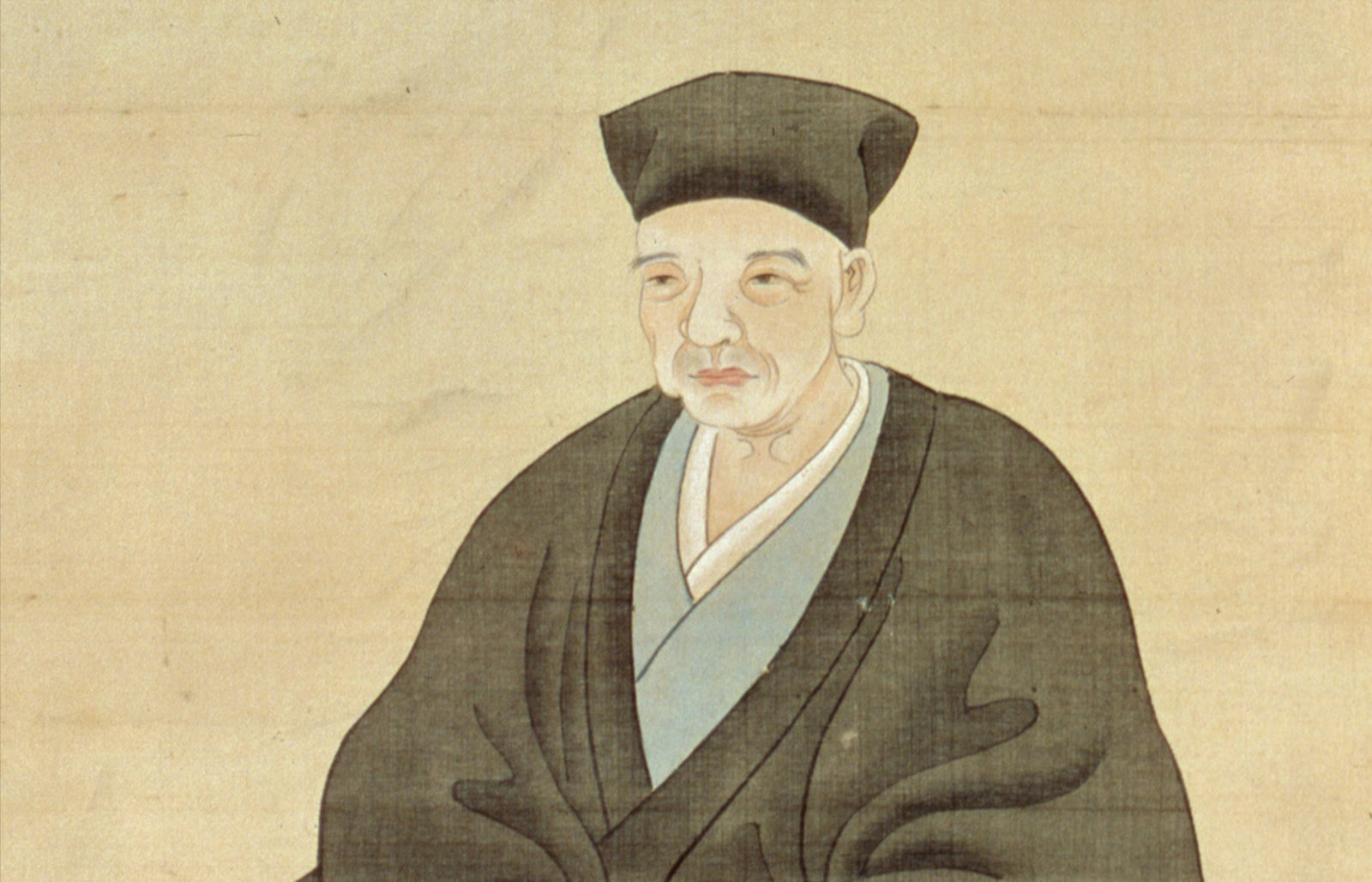ジミー・バーリッジとイアン・チャン著『茶道の政治』
(画像:千利休、 堺利休と明子のプラザ堺市博物館蔵提供。大阪を訪れる機会があればぜひ訪れるべき、小さいながらも素晴らしい博物館です)
茶道(ちゃどう)、茶の湯(ちゃのゆ)、茶事(ちゃじ)は、今日西洋ではJapanese Tea Ceremonyと呼ばれています。これらの用語はそれぞれ、「お茶の道」、「茶の芸術」(文字通り「お湯」)、そして「茶会」と訳されます。いずれの場合も、これらの翻訳は明らかに社会的かつ美的な慣習を示唆しており、おそらく宗教的な意味合いも含んでいると考えられます。今日、多くの人がJapanese Tea Ceremonyとして思い浮かべているものは、商人の間で人気を博し、16世紀に武士階級に取り入れられた茶道の様式に由来しています。
千利休は、日本の茶道の歴史において最も著名な人物であり、最も有名な茶道の三流派(現在も約70の流派が存続)の創始者です。彼は戦国時代(1467~1615年)の最盛期に生き、茶道の隆盛に最も大きな影響を与えた人物です。彼は、今日の茶道と結びつく侘びの茶道を広めましたが、創始者ではありませんでした。侘びの茶道は、それ以前の数世紀にわたり、美的、宗教的、文化的、経済的、政治的に広範な影響を与え、宗教階級、商人階級、そして武家階級の間で発展していきました。
さらに、当時の茶人コミュニティはまさに茶道の実践者たちのコミュニティであり、茶道の影響を多く取り入れ、レジャー、ビジネス、政治のあらゆる場面で茶を活用しようと試みていました。歴史的証拠は、織田信長、豊臣秀吉、徳川家康といった「天下統一の立役者」の時代における茶道が、政治的利益の促進や外交手段としても利用されていたことを強く示唆しています。
茶道のルーツ
茶は、805年頃、中国で30年間仏教を学んだ慧中(えいちゅう)僧侶によって中国から日本に初めて伝わったと考えられています。茶は主に中国の影響を帯びており、道教、儒教、仏教の要素が色濃く反映されていました。茶は万能の滋養強壮剤として考えられていましたが、その使用は貴族や寺院に限られていました。庶民にも商人にも茶の飲用は広まらず、895年以降まもなく廃れてしまいました。
茶文化の復興は、宋朝中国から新しい茶の種子と喫茶の習慣を持ち込んだ栄西(1141-1215)僧侶によって可能になりました。栄西は、プーアル茶のような茶筅を粉末状にし、泡立てて作る茶文化を広めました。栄西は、この新しい茶文化を健康に良いものとして広めましたが、僧侶たちもこの茶を飲み、中国の仏教寺院から持ち帰った経典をもとに、茶の点て方と喫茶の儀式をさらに発展させました。茶は、最もありふれた体験を完璧に行うことで悟りを開いたという体験をもたらしました。
この時代、修道院の外では、茶文化は対照的な二つの側面を発展させました。第一に、茶は上流階級の娯楽であり、彼らは茶を一種の庭遊びとして社交的に楽しみ、時には酒や賭博も伴いました。第二に、商人たちの間では、人間関係を築き、信頼を獲得し、商売を話し合う手段として、正式に茶を淹れ、飲まれました。
利休とゆかりのある茶のスタイルの先駆者や影響を与えた人物には、悟りの経験は茶を点てて共に過ごすという最もありふれた経験の中にあるという考えを提唱した禅僧の一休宗純(1394-1481)がいる。宗純はおそらく追放された僧侶の村田茂吉(珠光)(1423-1502)に茶を教えたと思われる。茂吉は今度は、僧院での茶の儀式、社交的な茶会、草庵風の茶室(僧侶の庵を思わせる簡素で小さな畳の部屋)という、侘び茶の始まりを示す3つの大きな影響を結集させた。珠光は自身の美学を「冷えた、乾いた」と表現した。尚光の養子である宗州は、京都の中心部に丹念に作り上げた茶室で茶会を主催した。尚光のもう一人の弟子である宗吾は、有名で貴重な品々を拒絶した最初の非僧侶の一人として知られている。竹野紹鴎(1502-1555)は、堺で有力な茶人であり商人でもありました。彼は茶道の美学を「侘び」 (質素)という言葉で表現し始めました。彼はまた、当時流行していた連歌の達人でもあり、茶道に別の影響を与えたことを示唆しています。
紹鴎は、千利休(1521-1591)と同時代の茶人であり商人でもあった今井宗久(1520-93)の活躍を後押ししました。利休は、茶人北向道珍のもとで、より正式な東山茶の様式(貴族、武士、禅の影響が融合した様式)を修めた後、紹鴎から侘び茶を学びました。貴族や武士に好まれた東山茶会は、12世紀から15世紀の貴族の茶を彷彿とさせ、名品や貴重品を豪華に展示することが典型的でした。こうした豪華な催しは、亭主が自らの富を誇示し、一種の権力政治を行う機会となりました。一方、より親密な商人風の茶会は、参加者同士の特別な会合、内緒話、取引の機会を提供しました。こうした先例から、茶は政治的駆け引き、外交、そしてソフトパワーの手段として利用されるようになりました。
茶道政治
1467年の応仁の乱は日本の封建制を崩壊させ、100年以上にわたる戦乱(戦国時代)の幕開けとなりました。この混乱の時代は、天下人として知られる三大武将の最後の一人が、茶を政治手段として活用することで、日本の大部分を中央集権化したことで終わりを迎えました。戦国時代の大部分において、「茶と政治は密接に結びついていた」(Bodart, 1977)。実際、三天天下の筆頭とされ、利休の最初の高官的支援者でもあった織田信長は、「茶の湯政治」という言葉を用いていました。
上述のように、茶は富と地位を示す社交的かつ儀式的な用途として、長年にわたり貴族や武士階級の娯楽として親しまれてきました。商人階級によって発展し、好まれた簡素な侘び風の茶道は、武将たちの支持を得るに至ったと考えられます。それは、茶道が彼らの政治的思惑を3つの点で推進したためです。第一に、商人は重要な物資へのアクセスを支配していたからです。第二に、茶は外交や同盟締結の手段でした。第三に、茶道を行うことは、ソフトな政治的権力を行使し、文化資本を獲得し、ある種の政治的正統性を示す手段でした。
武将たちは、商人との親密な個人的な関係を維持し、優遇措置を継続するために特定の商人を優遇することさえ戦略的だと考えていました。当時の宗久らの茶事日記は、茶道が有力商人と武将の取引に内在する商業的・政治的関係において重要な役割を果たしていたことを強く示唆しています。利休と同様に、宗久も京都の下流に位置する大坂近郊の重要な港町、堺の商人でした。有力武将は大坂と京都の両方に重要な城を構えていたため、堺商人との関係は戦略的に重要でした。
宗久は、堺の信長への服属を仲介するなど、戦乱の時代を生き抜き、商人としての富と茶人としての地位を信長の治世下で築き上げました。信長の助力を得て、塩や魚の塩漬けといった伝統的な商品の取引権だけでなく、近代戦の武器となる火薬、銀、鉄、鍛冶、銃砲製造のための鉱山や工場も所有するようになりました。他の有力商人たちも茶人であり、同様に信長の寵愛を受けていました。利休自身もかつて弾薬商として働いており、重要な物資を必要とする武将にとって理想的な窓口となっていました。茶人らと友好的な関係を維持し、さらには茶人として雇用したことが、かつて武家が好んでいた豪華な茶の湯が、商人たちによって築き上げられたより質素な侘びの美学に取って代わられた一因かもしれません。 1575年には、信長が利休に鉄砲の弾1000発を贈ったことへの感謝を述べた手紙も残っている。
信長は、茶会を主催し、貴重な茶道具を所有することで政治権力を獲得できると考えていました。そのため、信長の茶道政治は、高価な茶道具を所有し、重要な儀式への招待を精選し、茶人の官職を慎重に委譲し、誰が茶を指導できるかを統制し、他者が茶会を主催することを禁じることなどから成り立っていました。三天王の最後の一人である東宮川は、家元制度の基礎を築くことで、茶の湯の担い手とその方法に対する支配力をさらに強固なものにしました。この制度は、今日に至るまで茶道界を支配し続けています。
貴重な茶道具を戦略的に贈与することも、権力の委譲と維持のもう一つの形態でした。利休は信長の秘書兼仲介役として働き、茶道具などの適切な贈り物が特定の人物に戦略的に贈られるようにしました。よく引用される例としては、利休が特定の武将に特定の茶釜を贈ることを勧めたというものがあります。信長は裏切られ自害を余儀なくされた際、他人に使われないよう、自身の遺体と貴重な茶道具を焼却するよう命じました。
信長の死後、かつて信長の軍勢を率いていた豊臣秀吉が権力を握りました。それまで教養のなかった秀吉にとって、茶は洗練された存在であり、才能ある農民から大成功を収めた武将へと成長したというイメージを示す上で特に重要でした。茶を点てることは、秀吉にとって「洗練さ、社会的地位、そして政治的正統性」を示す場となりました(Kaufman, 2018)。
1585年、秀吉と利休は天皇に政治的に極めて重要な茶会を献上しました。秀吉は天皇から関白の位を、利休は茶の宗匠の位を賜りました。これらの称号により、二人は文化的・政治的に非常に大きな正統性を獲得しました。後に利休は、1587年に前例のない規模と豪華さを誇示した北野大茶会の開催に尽力しました。これは表向きは秀吉の九州における戦功への感謝を示すためのものでしたが、同時に秀吉の文化的優位性を示す手段でもありました。
利休と秀吉は、茶道においても政治においても緊密に連携しました。秀吉が遠征に出ている間、利休は大坂城を任され、軍事上の機密情報を受け取り、対応しました。また、利休は自らの威信をソフトパワーとして活用し、対立を外交的に解決させることにも成功しました。1586年には、利休は同盟国であった大友宗麟と他の大名の間の紛争を茶道外交によって解決しました。文献には、戦の前に高位の武士が茶会に出席し、彼らを敬うとともに、人生の美しい無常について瞑想する場として利用されていたという記述さえあります(Cross, 2009)。
もう一つの重要な事例として、利休は「茶の宗匠」としての地位と尊敬を利用し、九州の有力武将である島津義久から秀吉を日本の統治者として承認させるのに貢献しました。東北地方では、利休は反抗的な武将である伊達政宗が秀吉を統治者として承認するよう、和議交渉に尽力しました。
日本の茶道の歴史を概観すると、茶道が単一の人物によって創始されたのではなく、政治的、経済的、文化的、そして美的影響が複雑に絡み合った結果生まれたことが明らかになります。同様に、茶道の政治的役割は、茶道の美学に焦点を当てる多くの茶道評論とは対照的です。実際、商人風の侘び茶が政治的な役割を果たしていなければ、茶道の主流にはならなかったかもしれません。
この記事の情報には、以下の記事と書籍が参考になりました。
- ボダール・ベアトリス・M. 1977. 『茶と助言:利休の政治的役割』モニュメンタ・ニッポニカ32 , 49. https://www.jstor.org/stable/2384071から入手可能
- クロス・ティム. 2009. 『日本茶のイデオロギー:主体性、無常性、そして国民的アイデンティティ』ケント、英国:グローバル・オリエンタル社. ISBN 9781905246755
- カウフマン・キャシー. 2018. 『シンプルな一杯のお茶:秀吉の日本における権力政治と美学、1582-1591』ダブリン・ガストロノミー・シンポジウム2018 - 食と権力. 1–7. 入手先: https ://arrow.tudublin.ie/cgi/viewcontent.cgi?article=1125
- ワツキー アドリュー M. 1995年。商業、政治、茶:今井宗久(1520-1593)の生涯。モニュメンタ・ニッポニカ50 、47–65。 https://www.jstor.org/stable/2385279から入手できます。



2件のコメント
Great article! This is extremely informative and very well written. Thank you for sharing!
this was not to helpful but it works, so ty